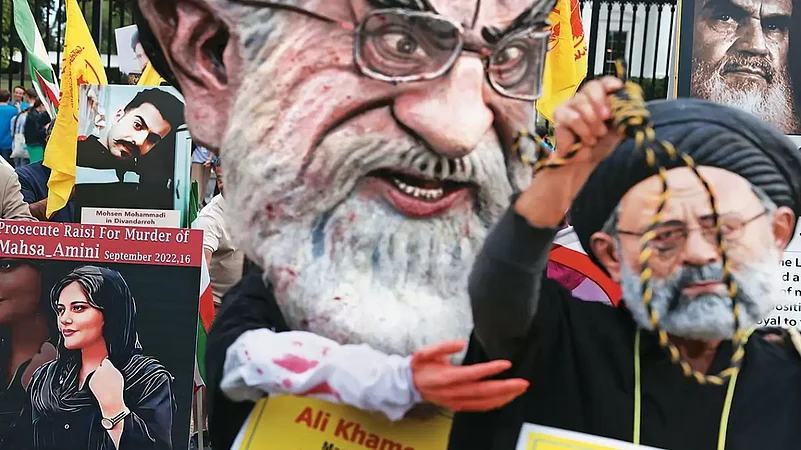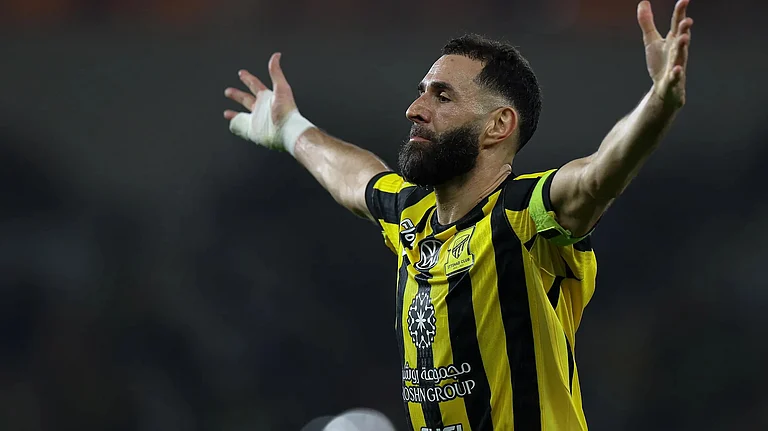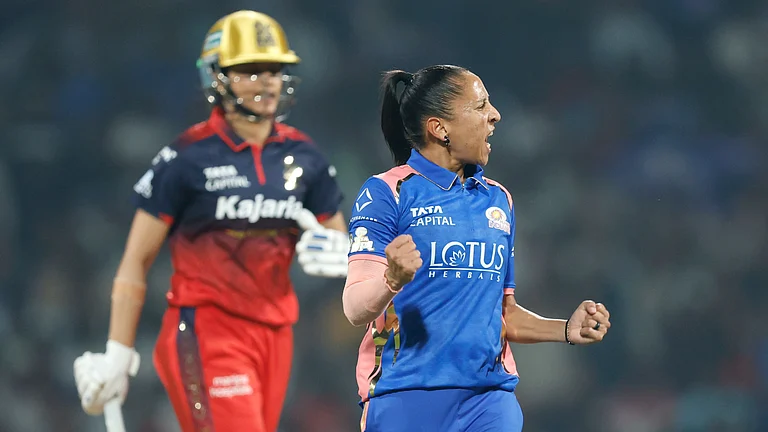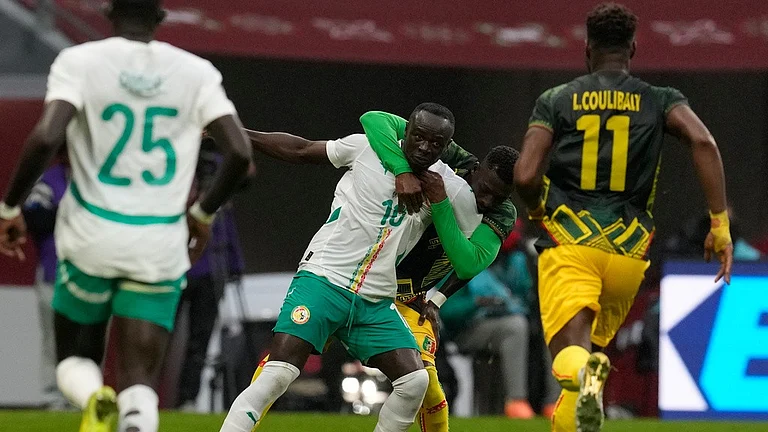I vividly remember the third day of the #Woman-Life-Freedom uprising. It was September 21, 2022, and I was in a hospital in California for the birth of my first child, my daughter, as the protests unfolded on the streets of Iran. I was excited to see Iranian women protesting against the Islamic Republic with men supporting them. I was sad to see the brutal oppression of the security forces. And I was very happy because women were finally asking, loud and clear, for their rights.
I was born and raised in Iran. I lived and worked there until I was 28. I experienced the humiliation of being a woman in Iran. I was not allowed to sing. I was not allowed to dance. I was forced to cover my hair in public starting at the age of seven.
For years, we, Iranian women, pushed back against the compulsory hijab by wearing shorter, tighter and more colourful clothing. In 1998, I refused to wear the maghnaeh when I went to university. Maghnaeh is a scarf sewn tight under the chin so it doesn’t fall off. It is part of the school uniforms for girls. I felt ugly in it. It felt suffocating. I wore a simple scarf instead. Left to me, I would have not covered my hair at all but that would have meant no education, no jobs and no presence in public. I eventually left the country because of it.
In 2017, during a visit back home, I walked the streets of Tehran without wearing a hijab in an act of social disobedience. It felt right. It felt empowering. I wished more women did it. I wished for freedom for women in Iran. In September, as I was sitting on a hospital bed watching Iranian women burning their scarves on the streets, I knew something new was in the air.
What’s happening in Iran is extraordinary.
The Big Shift
Since the death of Jina Mahsa Amini in September 2022, the streets of 160 cities in Iran have witnessed brutal clashes between the security forces of the Islamic Republic and Iranian protesters who want freedom from a theocratic dictatorship that uses resources of the country to advance its own ideological agenda rather than improve the well-being of its citizens.
The images that poured out of the country, the courage, and the persistence, awoke millions of Iranians in the diaspora from their depressed, zombie-like state caused by the trauma of having lived in a fascist state that controlled every aspect of their lives—from the clothing they wore to the music they listened to and the ideas they believed in. The Iranians in the diaspora also took to the streets, echoing the voices of people inside Iran and putting pressure on Western countries to stop making deals with the Islamic Republic of Iran.
This shook the world and finally, after 43 years of the Islamic Republic’s rule in Iran, the minds of the politicians of Western countries were changed. They felt that if they do not recognise the Islamic Republic as a legitimate state and treat it as the terrorist state it is, there might be a chance for an alternative government in Iran that sought peace and prosperity in the region.
In January this year, the United States imposed sanctions on Iran’s Islamic Revolutionary Guard Cooperative Foundation and some senior Iranian officials. The measure was meant to step up pressure on Tehran over its deadly crackdown on protests as the regime’s security forces have killed and seriously injured hundreds of civilians. The European Parliament considered adding the Revolutionary Guard to the list of terrorist organisations.
Arbitrary Executions
For one thing, the Islamic Republic will continue, with all its might, to crack down on the uprising and discourage people from taking to the streets in protest. Excessive use of lethal force, shooting protesters in the face with pellet guns, and using rape as a method of torture are a few of their tactics.
Maryam, a 42-year-old woman from Tehran, who works in a school, says she joined the protests as soon as they started. “I thought what happened to Amini could happen to anyone, including me. My personal life was affected and I felt I needed to go and show my protest,” she says. In the first month, she and her brother went to a protest almost every day. “After a month, I didn’t go. I was afraid because the cost of attending them was really high,” she adds.

The Islamic Republic threatens the families of victims into silence, and there are no official statistics of the dead and injured. However, according to a report published in December 2022, at least 481 people have been killed and 18,242 individuals have been arrested.
To deter people from protesting, the judiciary is sentencing the detainees to long imprisonments and has slapped some with vague charges such as Moharebeh (enmity against God) or Mofsed-e-filarz (corruption on earth), both of which carry an execution sentence under Sharia law.
A report published at the beginning of December by Amnesty International warned that 28 people, including three teenagers, were at risk of execution. Since then, four protesters have been executed, of which three were named in that report.
Mohsen Shekari, a 23-year-old video gamer who worked in a cafe and dreamt of becoming a YouTuber, was accused of drawing a weapon “with the intention of killing, causing terror and disturbing the order and security of society”, and was charged with “enmity against God”. He had blocked a road and non-fatally wounded a ‘Basiji’, a member of a volunteer-based paramilitary organisation who played a significant role in suppressing the protesters. He was executed on December 8 while his family was still waiting on an appeal.
Four days later, 23-year-old Majidreza Rahnavard was hanged publicly, presumably to fulfil a request by a senior police commander asking for a fast public execution as “a heart-warming gesture towards the security forces.”
Mohammad Mehdi Karami, a 20-year-old karate champion, and Sayed Mohammad Hosseini, a 30-year-old factory worker, were executed on January 7, both of whom were charged with “corruption on earth”. Neither had access to a lawyer of their choice during their short and controversial trial.
On January 9, hundreds of protesters gathered at the Rajayi-shahr prison in Karaj city—close to Tehran—when word circulated that protesters Mohammad Ghobadloo and Mohammad Boroughani had been transferred to solitary confinement ahead of their scheduled execution. Two days later, judicial officials of the Islamic Republic announced that Mohammad Boroughani’s execution was suspended for a retrial and no one has been executed since. It was a great victory for the people of Iran.
Rape, Torture in Custody
The Islamic Republic treats its detainees horribly. A CNN special report titled ‘How Iran’s security forces use rape to quell protests’, published in November 2022, describes how the Islamic Republic is using rape as torture on both men and women. This is ironic because this uprising was started by the death of Amini over not wearing the hijab, a practice that the Islamic Republic claims is for protecting women against sexual assault and rape.
The same report extensively looked into the case of Armita Abbasi, a 20-year-old detainee who was brought to the hospital because of bleeding caused by rape. The hospital staff informed her family of her situation but before her family reached the hospital, she was taken away by plainclothes officers.
The Islamic Republic denies the rapes, hoping that the detainees do not talk about this type of abuse as Iranian culture tends to blame the victims in cases of rape. But it is inevitable. In a prison in Urmia— the largest city in the West Azerbaijan province, adjacent to Kurdistan—a woman who was kept with recently-detained protesters allegedly told the other inmates that at least eight recently-arrested women were tortured and raped. As per reports, another inmate delivered a message to the general ward on a small piece of paper which read: “Get a pack of LD pills, birth control pills, for the newly-arrested women.” The women were said to be aged between 17 and 23. My heart breaks for these girls.
Many Kurdish people who started the fire of this uprising are lodged in Urmia.
Mohammad is a 16-year-old Kurdish boy from the small town of Bukan, 35 km away from Saqez where Amini lived. He has participated in many protests and has been arrested, electrocuted and beaten. He told me when the agents were hitting him, they were laughing at him. “Every time they hit me, they said ‘Ya Ali’ or ‘Ya Hossein’, calling on the first and the fourth Shai Imam to help them. They treated me like a toy rather than a human being,” he says.
Mohammad said he participated in these protests because he couldn’t be silent when his sister, mother and other family members can’t go out freely without fear. He protests because he is supposed to have a share of the country’s resources but instead all he receives are beatings and the deaths of loved ones.
“When in my country, [people] can’t choose their religion and don’t know the meaning of freedom, I am willing to risk my life to make this happen not only for my family and myself but for everyone in Iran,” says Mohammad. His tooth was knocked out when he was beaten. He sends me a picture that shows him with a missing tooth. He is smiling in the picture. He says he participates in as many protests as he can. “We have a strong adversary. We need to work hard, plan, and unite so we succeed. I am certain that these protests will make something happen and we will find freedom. Woman! Life! Freedom!”
Zin, Ziyan, Azadi or ‘Woman! Life! Freedom!’ has defined this uprising. The slogan, originally marking the political activities of Kurdish women in the 2000s, is one of the top-three slogans people chant on the streets besides “death to the dictator” and “death to Khamenei”, the former Supreme Leader of Iran. Kurdish people are among those who faced the most violence but are still standing strong against the Islamic Republic. Baluch people are right beside them.
Every Friday, after prayers, the people of Zahedan in Sistan and Baluchistan province take to the streets and chant “death to the dictator” and “death to Khamenei.” This is despite the massacre of the people of Zahedan on September 30 in which 96 people, including 13 children, were killed. The death made them angrier and more determined to overthrow the Islamic Republic.
These days, there are not as many protests in the country but a sense of change and hope is still in the air. At night, when the dark provides a bit of anonymity, people go to the rooftops and cries of “death to the dictator” fill the night and remind the people who are subjugated by their government that they are not alone and like the ambers beneath the ashes, the hope for a free Iran is alive and biding its time to take another step forward.
(Names of the interviewees have been changed to protect their identities)
(Views expressed are personal)
Elnaz Sarbar Boczek is an Iranian women’s rights activist based in California





















